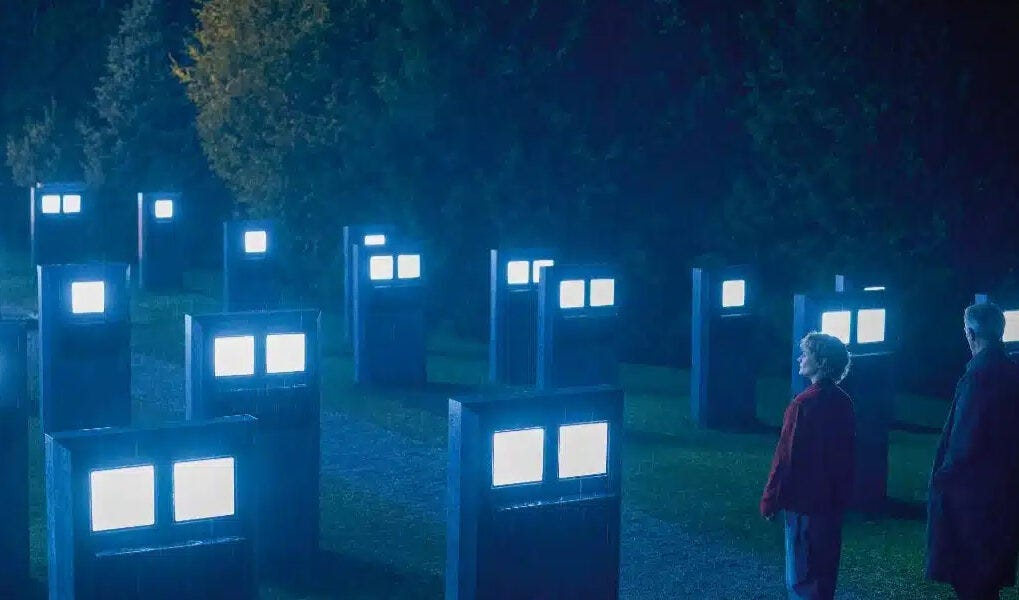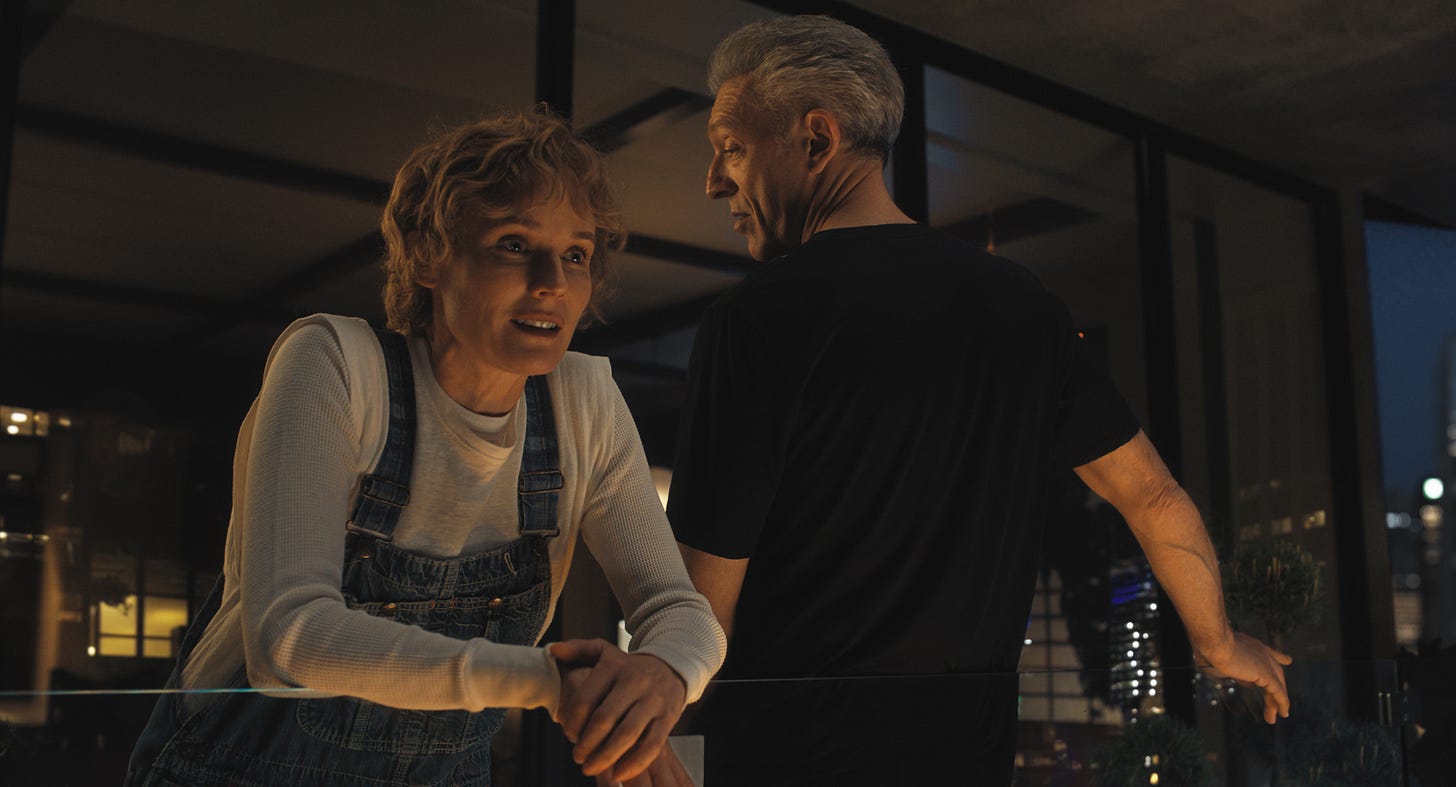Earlier this month, I named David Cronenberg’s The Shrouds my film of the year, and on rewatch, I thought it was just as extraordinary. This is one of the most uncomfortably intimate films I think I’ve ever seen. It’s hushed and spiritual, but excises any sort of ceremonial distance. It’s simultaneously laugh-out-loud hilarious and utterly devastating. Has dream logic in narrative cinema ever had this level of physical immediacy? This time, with a better understanding of the film’s pitch-black humor and its lilting rhythms, I latched onto the way Cronenberg’s spectral romance/mourning procession for late wife of over four decades is intimately tied to the present moment. The Shrouds heartbreakingly confronts grief as physical and sexual absence, and does so in part by contextualizing itself in the digitally-mediated dystopia of 2025.
The inscrutable plot is one of criss-crossing projections, and its the consistent inconsistencies of the narrative that lay the groundwork for The Shrouds’ hypnotic, stilted sorrow. Vincent Cassel plays Karsh, a tech entrepreneur who in the aftermath of his wife’s death, founded Gravetech, a startup whose cinematically-outfitted burial shrouds allow family members to observe the bodies of their loved ones as they lay beneath the ground. For Karsh, the idea stemmed from his desire to be in the grave with Becca, and presumably, the experience of GraveTech is as close as modern technology can get to providing that physical proximity.
Of course, a side effect of this experience is that Karsh, who is constantly reminded of his physical separation from Becca, has failed to move on. As The Shrouds progresses, he becomes caught in a web of inscrutable conspiracies. Karsh, who projects Becca’s image onto practically every woman he meets, finds himself questioning the intentions of Becca’s oncologists after discovering mysterious growths on his GraveTech feed. Simultaneously, Karsh’s GraveTech’s cemetery is vandalized, and the internal investigation that ensues seems to implicate everyone from Karsh’s relatives to the Russian, Icelandic, and Chinese governments.
The twin mysteries ultimately converge, and as Karsh’s understanding is continuously upended, Cronenberg painfully underscores the instability of surface. Despite the gloomy sterility of its digital format, The Shrouds’ high-definition objectivity is merely decorative. Karsh’s closest relatives, Becca’s sister Terry and her ex-husband Maury, are both paranoid conspiracy theorists whose motives remain unnervingly murky, and modern technology is exposed as an elaborate simulacra whose fallability has infected humanity right down to its subconscious. Karsh’s GraveTech shrouds, which livestream the decomposition of Becca’s body in 8K, remain susceptible to digital tampering. Hunny, an AI chatbot based on Becca’s image is revealed as a vehicle for jealous subterfuge with access to both Karsh’s data and his nightmarish memories. Karsh’s grief drives his digital entrepreneurship. With postmodern conspiracies emitting from every screen character, Cronenberg suggests that society’s desire to approximate the body, whether through AI, virtual reality, or even Apple FaceTime, is driven by a collective sense of loss.
Going into this viewing, Neil Bahadur’s Letterboxd review of the film clued me into Cronenberg’s uncanny treatment of screens. The Shrouds contains an inordinate number of sequences that simply observe phone videos for extended periods of time. Often shot in shallow-focus extreme close ups, Cronenberg frames his devices with super-sized flesh and negative space. The most disorienting of these scenes occurs near the end of the film, when an iPhone video “reveals” that Karsh’s duplicitous ex-brother-in-law Maury may be the entity behind the vandalization of Karsh’s graves. Framed such that the the top and bottom edges of the screen are cut off, the mixture of motion and stasis turns the screen into a rupture in the fabric of reality. If The Shrouds feels uniquely contemporary, it’s in part due to Cronenberg’s inventive expression of the ways the digital has infiltrated the physical.
Of course, all of this focus on the digital only accentuates the primacy of the body, the famous subject of Cronenberg’s corpus. When asked by sister-in-law Kerry about the importance of Becca’s body, Karsh responds that it was “the only place [he] really lived. Her body was the world. The meaning and the purpose of the world”. Touch is paramount for the characters in The Shrouds, where Toronto has expanded from icy, modernist wasteland of Crash to a tech-infested unreality where any sense of certainty is tethered to the sensation of partner’s body and the comfort of being held. It’s no surprise then that Karsh’s only real romantic interest throughout the film is Soomin, the visually-impaired wife of an ailing European businessman. She initiates their connection by touching his face while the pair commiserate over the physical distance disease placed between themselves and their partners. In the end, it’s Soomin and her touch that brings The Shrouds to its surreptitious non-conclusion, a flight into the sunset which romantically implies that while Karsh will never get over his love for Becca, he may have found a piece of her in a new partner.
The Shrouds is distributed by Janus/Sideshow and is currently playing at the SIFF Uptown.






I’m glad to read a different perspective because I couldn’t engage with this film at any point. The script is quite awful.